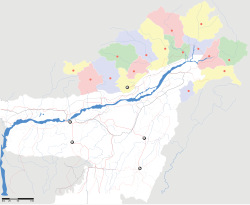The East Kameng district is located in Arunachal Pradesh, India. It shares an international border with Tibet in the north, a state border with Assam and district borders with West Kameng, Papumpare and Kurung Kumey, who bifurcated from Lower Subansiri on April 1 2000. Under the Chinese sovereignty claim, East Kameng would fall under the jurisdiction of Cuona of Shannan Prefecture of the Tibet Autonomous Region.
Geography
Like West Kameng, the East Kameng climate ranges from arid in the tundra of the north through a cool temperate climate to a humid subtropical climate in the southern sub-himalayan hills bordering Assam.
Economy
Most tribes practise a form of slash and burn agriculture known as Jhum. After clearing the land, crops like barley and rice are planted, and fruit trees are planted to make orchards. Fishing activities first started between 1965-66 and gained momentum in November 1980, when the Fishery Department first started functioning independently. As of today, the Fishery development activities are headed by a District Fishery Development Officer, who was originally the Superintendent of Fisheries. However, this department was understaffed. Funds were also given for rural agriculture and Paddy-cum-Fish Culture activities.
With the advancement of modern technology, horticulture based on apples and oranges is becoming increasingly popular. Today, temperate and sub-tropical fruits are planted in orchards with chemical fertilizers.
People
East Kameng is inhabited by various tribes of similar origin but with distinct cultures and beliefs, practising the Donyi-Polo religion. The most populous of these, the Nishi, are scattered throughout the entire district. Other tribes, especially the Miji, Sulung and the Aka, are found in regions near the Kameng river.
Since independence, much of the population has relocated to the district capital, Seppa. With the coming of modernism, festivals such as the Sarok of the Aka, Nyokum of the Nishi, Jonglam-Ponklam and Chindang of the Miji and the Gumkum-Gumpa are celebrated in full flair in Seppa.
Koro
Main article: Koro language (India)
The Koro is a Tibeto-Burman language spoken by approximately 800–1200 people in the East Kameng district who live among the Aka (Hruso), but their language is distantly related, with distinct words for basic vocabulary.[1][2] Although it has resemblances to Tani further to the east, it appears to be a separate branch of Tibeto-Burman.[3] Koro is unlike any language in the various branches of the Tibeto-Burman family.[4] Researchers hypothesize it may have originated from a group of people enslaved and brought to the area.[5]
Koro was recognized as a separate language in 2010 by a linguistic team of David Harrison, Gregory Anderson, and Ganesh Murmu while documenting two Hruso languages (Aka and Miji) as part ofNational Geographic's "Enduring Voices" project.[1] It was apparently noticed by earlier researchers.
History
The area around the Kameng river has at various times come under the control and influence of the Mon kingdoms, Tibet and the Ahom kingdom. Aka and Nishi chiefs would exert control over the area whenever no major political powers dominated the area.
The Kameng Frontier Division was renamed as the Kameng District. The Political Officer was also redesignated as the Deputy Commissioner of Kameng. However, for political reasons, the Kameng district was bifurcated between East Kameng and West Kameng on June 1, 1980.
Tourism
East Kameng has some tourist attractions. One of these is the Pakhui Tiger Reserve, with a wide range of wildlife. Seppa, the capital, hosts beautiful tribal dance festivals that adds color to the natural landscape. The Himalayas can be viewed from the hill stations of Bameng, Chayangtajo and Pakke-Kessang.
| East Kameng | |
| — district — | |
| Coordinates | 27°21′00″N 93°2′44″ECoordinates: 27°21′00″N 93°2′44″E |
| Country | |
| State | Arunachal Pradesh |
| Capital | Seppa |
| Population • Density | 57,179 (2004) • 14 /km2 (36 /sq mi) |
| Literacy | 40.7%% |
| Time zone | IST (UTC+5:30) |
| Area | 4,134 square kilometres (1,596 sq mi) |


No comments:
Post a Comment